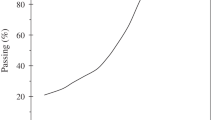Abstract
The Portland cement manufacturing process produces considerable amount of cement kiln dust (CKD). While many facilities are able to reuse a significant portion of CKD in their production lines, a large percentage is removed as industrial waste and placed in landfills. Because of the large amount of material potentially available for use, and in an effort to cut disposal costs, alternative and beneficial uses for CKD need to be investigated. This study presents experimental results of the use of CKD in modification and stabilization of soils from the Aberdeen and Everett areas in the state of Washington. These soils are typically wet of the optimum water content and pose problems during geotechnical construction. CKD was added in percentages of 5, 10, 15, and 20% by dry weight of the soils. Laboratory tests, including drying rate of the soils, Atterberg limits, standard proctor and unconfined compressive strength were conducted. Results of the investigation showed significant improvement in drying rate and unconfined compressive strength of the CKD treated specimens as the percentage of CKD increased. It was also found that lower percentages of CKD can be used for modification purposes, whereas higher percentages of CKD can be used for both modification and stabilization purposes in geotechnical construction.












Similar content being viewed by others
References
ASTM D4609-01 (2006) Standard guide for evaluating effectiveness of admixtures for soil stabilization. Annual Book of ASTM Standards, 4.08, pp 757–761
Baghdadi ZA, Fatani MN, Sabban NA (1995) Soil modification by cement kiln dust. J Mater Civil Eng 7:218–222
Baran B, Ertuk T, Sarikaya Y, Alemdarglu T (2001) Workability test method for metals applied to examine a workability measure (plastic limit) for clays. Appl Clay Sci 20:53–63
Beikman HM, Rau WW, Wagner HC (1967) Lincoln creek formation, grays harbor basin southwestern Washington. Geol Surv Bull 1244-I
Bennert TA, Maher MH, Jafari F, Gucunski N (2000) Use of dredged sediments from Newark harbor for geotechnical application. Geotechnics of high water content materials, ASTM special technical publication, STP 1374
Bhatty JI, Bhattacharja S, Todres HA (1996) Use of cement kiln dust in stabilizing clay soils. Portland Cement Association
Collins RJ, Emery JJ (1983) Kiln dust-fly ash system for highway based and subbases. Federal Highway Administration report, FHWA R/D-82/167. US Department of Transportation, Washington, DC
Kamon M, Nontananandh S (1991) Combining industrial wastes with lime for soil stabilization. J Geotech Eng 117:1–17
Kessler GR (1995) Cement kiln dust (CKD) methods for reduction and control. IEEE Trans Ind Appl 31:407–412
Lowell S (2005) Personal communication. Washington Department of Transportation, Tumwater
Mallela J, Quintus HV, Smith K (2004) Consideration of lime-stabilized layers in mechanistic-empirical pavement design. The National Lime Association
Materials Characterization Paper (2008) Cement kiln dust (CKD). In: Support of the advanced notice of proposed rulemaking identification of nonhazardous materials that are solid waste
Miller GA, Azad S (2000) Influence of soil type on stabilization with cement kiln dust. Constr Build Mater 14:89–97
Miller GA, Zaman M, Rahman J, Tan KN (2003) Laboratory and field evaluation of soil stabilization using cement kiln dust. Final Report, No. ORD 125-5693. Planning and research division, Oklahoma Department of Transportation
Parsons RL, Kneebone E, Milburn JP (2004) Use of cement kiln dust for subgrade stabilization. Kansas Department of Transportation, Division of Operation, Bureau of Materials and Research, Report No. KS-04-3
Report on Sustainable Manufacturing (2008) Solid waste production. In: Report on sustainable manufacturing. Portland Cement Association. Available via DIALOG. http://www.cement.org/smreport08/sec_page3_2.htm. Accessed 03 April 2009
Sariosseiri F, Muhunthan B (2008) Geotechnical properties of Palouse loess modified with cement kiln dust and Portland cement. In: Proceedings of Geocongress 2008, Geochallenge of sustainability in the Geoenvironment, New Orleans, LA
Si Z, Herrera CH (2007) Laboratory and field evaluation of base stabilzation using cement kiln dust. Transp Res Rec 2(1989):42–49
Sreekrishnavilasam A, Santagata M (2006) Development of criteria for the utilization of cement kiln dust (CKD) in highway infrastructure. Joint Transportation Research Program, Paper 272
Sreekrishnavilasam A, King S, Santagata M (2006) Characterization of fresh and landfilled cement kiln dust for reuse in construction applications. Eng Geol 85(1–2):165–173
Troost KG, Booth DB, Laparade WT (2003) Quaternary geology of Seattle. Geology Society of America, Field guide 4
Author information
Authors and Affiliations
Corresponding author
Rights and permissions
About this article
Cite this article
Carlson, K., Sariosseiri, F. & Muhunthan, B. Engineering Properties of Cement Kiln Dust-Modified Soils in Western Washington State. Geotech Geol Eng 29, 837–844 (2011). https://doi.org/10.1007/s10706-011-9420-2
Received:
Accepted:
Published:
Issue Date:
DOI: https://doi.org/10.1007/s10706-011-9420-2




